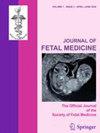异原型单绒毛膜双胎妊娠:新视角
IF 0.1
Q4 OBSTETRICS & GYNECOLOGY
引用次数: 0
摘要
单卵双胞胎被认为是完全相同的,因为他们是由一个受精卵产生的,但他们的先天缺陷、出生体重和遗传组成可能存在差异。不对称的 X 染色体失活、不平等的基因印记以及合子后有丝分裂错误(包括无丝分裂和无丝分裂滞后)都可能导致异型单绒毛膜双胞胎。我们报告了一例单绒毛膜双胎妊娠,尽管在无创产前筛查中常见的非整倍体(18 三体综合征)风险很低,但在产后检查中却表现出与 18 三体综合征相关的症状。短串联重复标记用于产后检查,以确认高度嵌合。这些标记显示,双胞胎 II 患有嵌合型 18 三体综合征,而双胞胎 I 则正常,从而排除了单亲裂殖症的可能,并确定了两个胎儿的单倍性。由于绒毛取样、单囊羊膜腔穿刺术或脐带穿刺术可能无法排除第二个胎儿的非整倍体,并可能产生假阴性结果,因此双囊羊膜腔穿刺术是一种可用于鉴别差异单绒毛膜双胎的产前诊断方法。為了及時診斷胎兒的合子率、進行染色體補 充、提供遺傳輔導及轉介進行選擇性減胎,建議進行雙胎羊膜腔穿刺。本文章由计算机程序翻译,如有差异,请以英文原文为准。
Heterokaryotypic Monochorionic Twin Pregnancy: New Perspective
Monozygotic twins are thought to be identical since they are created from a single fertilized egg, yet there may be differences in their congenital defects, birth weight, and genetic makeup. Asymmetric X chromosome inactivation, unequal gene imprinting, and postzygotic mitotic mistakes including nondisjunction and anaphase lag can all result in heterokaryotypic monochorionic twins. We report a monochorionic twin pregnancy that exhibited stigmata associated with trisomy 18 on postnatal examination despite a low risk of common aneuploidy (trisomy 18) on noninvasive prenatal screening. Short tandem repeat markers were used for postnatal examination to confirm high-grade mosaicism. These markers indicated mosaic trisomy 18 in twin II and normal in twin I, ruling out uniparental disomy and establishing monozygosity in both fetuses. Twin sac amniocentesis is a prenatal diagnostic procedure that can be used to identify discrepant monochorionic twins because chorionic villus sampling, single sac amniocentesis, or cordocentesis may not be able to rule out aneuploidy in the second fetus and may yield a false-negative result. For prompt zygosity diagnosis, chromosomal complement, genetic counseling, and referral for selective fetal reduction, twin sac amniocentesis is recommended.
求助全文
通过发布文献求助,成功后即可免费获取论文全文。
去求助
来源期刊

Journal of Fetal Medicine
OBSTETRICS & GYNECOLOGY-
自引率
50.00%
发文量
26
期刊介绍:
Journal of Fetal Medicine is the official journal of the Society of Fetal Medicine affiliated with International Society of Ultrasound in Obstetrics & Gynecology. This is a peer-reviewed international journal featuring articles with special interest to fetal medicine specialists, geneticists and ulstrasonologists. The aim of the journal is to communicate the results of original research in the field of fetal medicine. It includes a variety of articles suitable for clinicians and scientific specialists concerned with diagnosis and therapy of fetal disorders. All articles on health promotion of the fetus are acceptable for publication. The major focus is on highlighting the work that has been carried out in India and other developing countries. It also includes articles written by experts from the West. Types of articles published: - Original research articles related to fetal care and basic research - Review articles - Consensus guidelines for diagnosis and treatment - Case reports - Images in Fetal Medicine - Brief communications
 求助内容:
求助内容: 应助结果提醒方式:
应助结果提醒方式:


